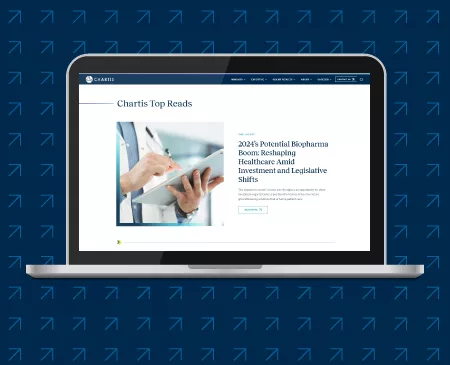The Buzz This Week
COVID-19 cases have been on the rise again in recent weeks, with Emergency Department (ED) visits and hospitalizations increasing since mid-July. Cases are expected to continue to rise with students and faculty heading back to school. Deaths from COVID have stayed relatively flat, though they are often a lagging indicator and may increase in the coming weeks. While case numbers are increasing, they remain significantly lower than prior years—cases are 2.5 times lower than 2022, and 5.5 times lower than 2021 during the same timeframe. With a fourth year of surging cases in the late summer, health officials and experts have speculated this may become an annual trend.
The average COVID hospitalization rate rose about 17% between June and July, and as of August 26, the 14-day change in hospitalization nationwide reached 30%, according to the Centers for Disease Control and Prevention (CDC). The Southeastern states saw the most dramatic increases in July. Hospitalization rates in Mississippi rose 73% month over month. Alabama and Louisiana both saw 66% hospitalization rate increases and the highest ED visit rates in the country. In August, 26 states had hospitalization rates that increased by more than 20% in a single week. South Dakota saw the biggest spike, where hospitalizations increased by 127%. As children and adolescent populations returned to school, case numbers significantly increased. 12- to 15-year-olds are now among the highest rates for ED visits.
The early summer spike was led by the XBB.1.5 variant. But since then, EG.5, a subvariant of Omicron also known as Eris, has emerged as the dominant strain across the county. A third variant, BA.2.86, is the newest variant identified, though numbers remain low, and is similar to Omicron in that it is more mutated and transmittable. An estimated 36 mutations distinguish it from XBB.1.5. At this time, the CDC has reported there is no indication that this variant produces more severe illness. Scientists are currently investigating whether the updated vaccines, targeting the XBB.1.5 variant, will be effective at protecting against EG.5 and BA.2.86.
The newest COVID boosters are still waiting for approval, which is expected in the coming weeks after the CDC’s expert vaccine panel meets September 12. Rollout would begin mid-September. These vaccines will be monovalent, targeting a single strain of the virus, and, for the first time, will not include the original version of the SARS-2 virus.
Why It Matters
The most recent COVID surge has resulted in numerous organizations reinstating previous COVID protective measures. Many schools in surge locations across the nation shut down or moved to remote learning for several days. Numerous health systems, including Kaiser Permanente, reintroduced mask mandates at some hospitals for staff, patients, and visitors. Despite evidence showing masking protocols are a low-cost efficacious option for reducing COVID transmission, many Americans are resistant to a return to mask mandates and closures. Unwillingness to follow mandates may place additional strain on health systems.
Tracking the trajectory of the variants has become increasingly more difficult as the end of the pandemic and public health emergency resulted in significantly decreased funding for surveillance nationally and globally. Surge tracking and projections are critical for healthcare workforce planning. With less monitoring, it is increasingly difficult to identify patterns in COVID cases. Established patterns allow the U.S. Food and Drug Administration (FDA) and the CDC to better time the rollout of booster shots, like influenza.
This COVID uptick comes at a less-than-ideal time regarding booster availability. The schedule for updated COVID boosters has moved to an annual cycle, which starts in the fall and coincides with the annual flu shot season as well as the new respiratory syncytial virus (RSV) vaccinations protecting older Americans and infants. Health officials are hoping to avoid a repeat of last year's "tripledemic," but with vaccine uptake declining with each successive booster, they face an uphill battle convincing a pandemic-fatigued public.
The updated boosters have been designed to target the XBB.1.5 variant due to its domination early in the season. It is expected that the updated boosters will still provide sufficient protection against the newly emerging strains, but research is still being conducted. In the meantime, the CDC has stated that the existing COVID tests are able to detect the new subvariants and that the antiviral drugs Paxlovid, Veklury, and Legevrio will be effective at treating it. The number of mutations may make the new BA.2.86 variant able to evade the immunity built up through vaccinations, infection, and a combination of the two, but there is not enough evidence to confirm either outcome.
While the rising numbers are not an indication of returning to the peak cases experienced during Omicron, they do serve as a reminder that COVID will remain a public health concern for the foreseeable future, and it is important to remain aware and vigilant about taking the appropriate protective measures.
RELATED LINKS
Axios:
Summer COVID Cases Are Rising: Here’s Where and Why
STAT:
Covid-19 Hasn’t Fallen into a Seasonal Pattern—Yet
Health Officials Lay out Plans to Cope with Respiratory Virus Season
Reuters: US CDC Says New COVID Lineage Could Cause Infections in Vaccinated Individuals
Editorial advisor: Roger Ray, MD, Chief Physician Executive.







